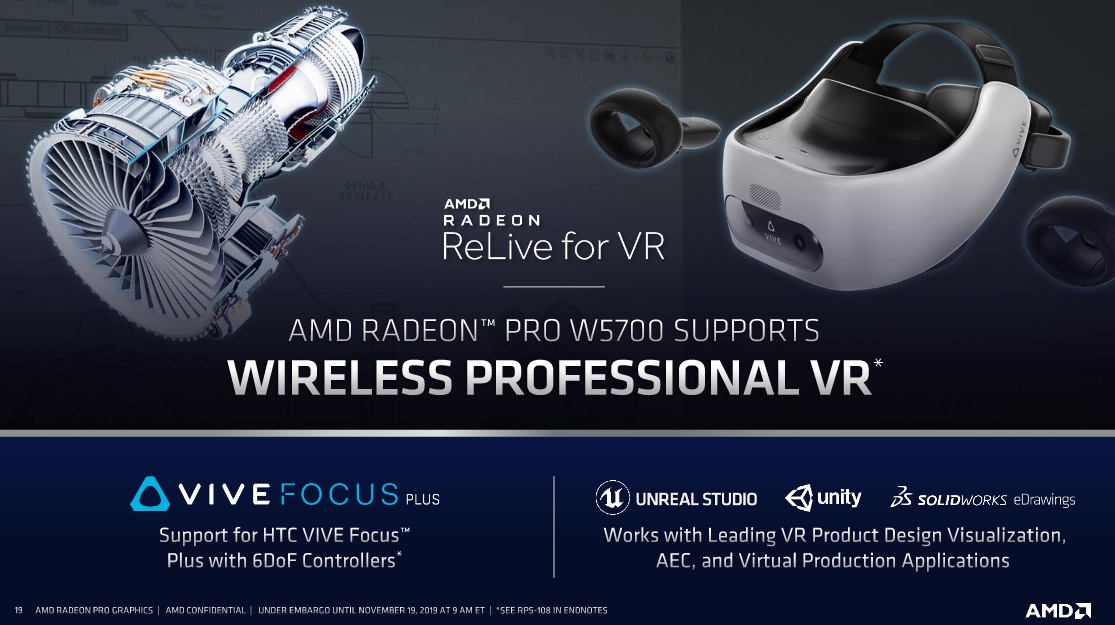AMD’s Radeon Pro W5700 Brings 7nm Navi to Workstations

AMD’s new workstation graphics card, the Radeon Pro W5700, will seem familiar to those who’ve been paying attention to the company’s recent RX 5700 consumer cards. The workstation variant is based on the same 7nm Navi-based silicon as the gaming-focused cards that share a similar name, but is designed for those who work in design, digital media, software development, finance, and fields. According to AMD, the W5700 is focused on emerging trends in design workflows such as GPU accelerated rendering, VR, and real-time visualizations, with an aim to increase productivity, improve product quality, and speed time to market.



As alluded to earlier, the naming convention has changed with this card. Previous-generation workstation-class cards from AMD used the “WX” prefix before the model number. With the new card, the “X” is dropped, and AMD has brought the numbering in line with its consumer cards. This change should help businesses more easily identify the performance class of the company’s workstation cards, assuming more will follow in the same vein.
Specification wise, the AMD Radeon Pro W5700 is based on the Navi 10 GPU and carries all of the architectural benefits of the company’s RDNA architecture, including redesigned geometry and compute groups, the Radeon media and display engines, as well as PCIe 4.0. The card sports 36 CUs (Compute Units), 144 Texture Units, and 64 ROPs. Clock speeds will be up 1,930 MHz (Boost), while typical clocks will be around 1,630-1,880 MHz, according to AMD. The W5700 includes 8GB of VRAM sitting on a 256-bit bus with 448 GB/s bandwidth. This yields up to 8.89 TFLOPS of FP32. In short, the base specifications line up with the Radeon RX 5700.

Connectivity to the workstation-class GPU is handled by six mini-Displayport connections as well as a single USB-C port.
| Header Cell - Column 0 | Radeon Pro W5700 | Radeon Pro WX 8200 | Radeon RX 5700 |
|---|---|---|---|
| Architecture (GPU) | RDNA (Navi 10) | Vega (GCN 5) | RDNA (Navi 10) |
| ALUs | 2304 | 3584 | 2304 |
| Peak FP32 Compute (Based on Typical Boost) | 8.89 TFLOPS | 10.8 TFLOPS | 7.5 TFLOPS |
| Tensor Cores | N/A | N/A | N/A |
| RT Cores | N/A | N/A | N/A |
| Texture Units | 144 | 224 | 144 |
| ROPs | 64 | 64 | 64 |
| Base Clock Rate | ???? MHz | 1200 MHz | 1465 MHz |
| Nvidia Boost/AMD Game Rate | 1630-1880 MHz | 1500 MHz | 1625 MHz |
| AMD Boost Rate | 1930 MHz | ???? MHz | 1725 MHz |
| Memory Capacity | 8GB GDDR6 | 8GB HBM2 | 8GB GDDR6 |
| Memory Bus | 256-bit | 2048-bit | 256-bit |
| Memory Bandwidth | 448 GB/s | 512 GB/s | 448 GB/s |
| L2 Cache | 4MB | 4MB | 4MB |
| TDP | 205W (less when not using USB-C) | 230W | 177W (measured) |
| Transistor Count | 10.3 billion | 12.5 billion | 10.3 billion |
| Die Size | 251 mm² | 495 mm² | 251 mm² |
Board power is listed at 205W and requires 6-pin and 8-pin PCIe connectors. AMD compared power use with that of the Nvidia Quadro RTX 4000 card, claiming the Pro W5700 is 18% more efficient running solid modeling, with negligible improvements at idle and model rotation. Compared to the WX8200, the new card averages up to 41% more efficiency in SPECviewperf13 tests (snx-03, creo-02, 3dsmas-06), the Enscape “Mansion” Demo, as well as the Unity Automotive benchmark.
Compared to the 14nm Vega-based cards, AMD says the W5700 performs better than the WX 8200, but is priced lower. The WX 8200 was released at $999, and while on the webcase was told the Radeon Pro W5700 to be less. On the performance front, with 4 CUs left on the table from a full Navi 10 GPU, it is possible we’ll see a higher-performing SKU in the future, perhaps one with more VRAM as well, like the WX9100.
Outside of the hardware, the cards come Enterprise-ready, with professional-grade software that is stress tested for 24/7 environments, and with extensive platform application testing to help ensure stability and 100% uptime. The Radeon Pro drivers are also released less frequently than consumer drives, four times a year. But AMD says this more predictable cadence benefits organizations and IT departments.
Get Tom's Hardware's best news and in-depth reviews, straight to your inbox.




Also trickling down to the workstation GPU is AMD Remote workstation, where users are able to connect to a capable workstation at the office from elsewhere and continue to work on a project as if you’re sitting in front of the workstation. Users are able to use Citrix or Microsoft Remote Desktop Services. Radeon ReLive for VR is also supported on the W5700, offering wireless professional VR capabilities using the Vive Focus Plus with its six depth-of-field controllers.
Additionally, Radeon ProRender, a photorealistic rendering solution from AMD, is supported as well and able to be integrated into an app or plugin. The point of the software, AMD says, is to “democratize rendering.” Radeon ProRender supports a slew of software including, but not limited to, Autodesk 3DS Max/Maya, Houdini, Solidworks, IntalLOD, Cinema 4D, Blender, and more.
The Radeon Pro W5700 should be available shortly after today’s launch. Pricing was announced the day before this release and will come in at $799.

Joe Shields is a staff writer at Tom’s Hardware. He reviews motherboards and PC components.